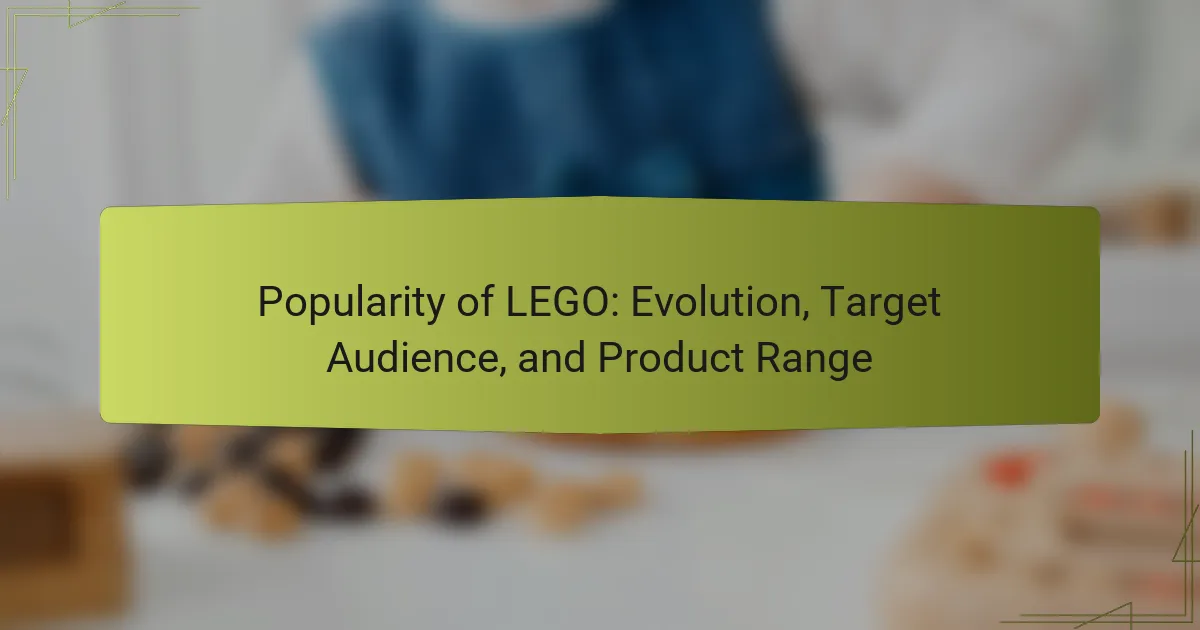LEGO is a globally recognized brand known for its high-quality, durable building sets that encourage creativity across a wide age range. The article explores LEGO’s enduring popularity, highlighting key factors such as diverse themes, including popular franchises like Star Wars and Harry Potter, and the brand’s commitment to educational benefits that promote STEM learning. Community engagement through events and platforms like LEGO Ideas fosters brand loyalty, while the company’s focus on sustainability aligns with the values of environmentally conscious consumers. Additionally, LEGO’s innovative marketing strategies and adaptability to changing consumer preferences contribute to its continued relevance in the market.

What factors contribute to the popularity of LEGO?
LEGO’s popularity is driven by several key factors. The brand offers high-quality, durable products that encourage creativity. LEGO sets appeal to a wide age range, from young children to adults. The diverse themes and licenses, such as Star Wars and Harry Potter, attract various interests. Community engagement through fan events and online platforms enhances brand loyalty. Educational benefits, like STEM learning, promote LEGO as a valuable tool for development. The company’s commitment to sustainability resonates with environmentally conscious consumers. These factors collectively reinforce LEGO’s enduring popularity in the market.
How has LEGO evolved over the years?
LEGO has evolved significantly since its inception in 1932. Initially, LEGO produced wooden toys before transitioning to plastic bricks in 1949. The introduction of the modern interlocking brick design in 1958 revolutionized construction play. Over the decades, LEGO expanded its product lines to include themed sets, such as LEGO Star Wars and LEGO Harry Potter. In 2004, LEGO faced financial difficulties but rebounded with innovative product development and partnerships. The company embraced digital platforms, launching LEGO video games and a robotics line called LEGO Mindstorms. Today, LEGO targets diverse age groups, offering sets for toddlers to adults. This evolution reflects LEGO’s adaptability in a changing market.
What key milestones mark LEGO’s evolution?
LEGO’s evolution is marked by several key milestones. In 1932, LEGO was founded by Ole Kirk Christiansen in Denmark. The company initially produced wooden toys and household items. In 1949, LEGO began producing plastic interlocking bricks, which became the foundation of its product line. The introduction of the modern LEGO brick design occurred in 1958, featuring a patented interlocking system. In 1968, the first LEGO theme park, Legoland, opened in Billund, Denmark. The 1990s saw the launch of LEGO sets based on popular franchises, including Star Wars. In 2004, LEGO faced financial difficulties but rebounded by focusing on innovation and collaboration. Today, LEGO continues to expand its product range and engage with diverse audiences globally.
How have cultural trends influenced LEGO’s development?
Cultural trends have significantly influenced LEGO’s development by shaping its product lines and marketing strategies. The rise of popular media franchises has led LEGO to create themed sets based on movies and television shows. For instance, the partnership with Star Wars began in 1999, resulting in a successful range of LEGO sets that appealed to both fans of the franchise and builders. Additionally, the increasing focus on diversity and inclusion in society prompted LEGO to introduce more varied character representations in their sets. The launch of the LEGO Friends line in 2012 featured female characters and aimed to engage a broader audience. Furthermore, environmental awareness has driven LEGO to commit to sustainable materials, with plans to produce all core products from sustainable sources by 2030. These adaptations reflect LEGO’s responsiveness to cultural shifts, ensuring its relevance in a changing market.
Who is the target audience for LEGO products?
The target audience for LEGO products includes children, teenagers, and [censured] fans. Children aged 4 to 12 are the primary demographic, as LEGO sets are designed to enhance creativity and problem-solving skills. Teenagers often engage with more complex sets that cater to their interests, such as themed collections. [censured] fans of LEGO, known as AFOLs ([censured] Fans of LEGO), have grown in number, leading to specialized sets that appeal to this group. The diverse range of products ensures that there is something for everyone, from educational sets to intricate models. LEGO’s marketing strategies also focus on family engagement, promoting collaborative building experiences. The broad appeal is supported by the brand’s iconic status and cultural presence, making it a favorite across generations.
What age groups are most engaged with LEGO?
The age groups most engaged with LEGO are primarily children aged 5 to 12 years. This demographic represents the core target audience for LEGO products. Engagement also extends to teenagers aged 13 to 17 years. Adults aged 18 and older are increasingly participating in LEGO building as well. According to a study by The Toy Association, 60% of LEGO sales come from children, while [censured] engagement has risen significantly in recent years. This trend indicates a growing market for [censured]-themed LEGO sets. The diverse range of products appeals to various age groups, enhancing overall engagement.
How does LEGO appeal to different demographics?
LEGO appeals to different demographics through diverse product lines and marketing strategies. The company offers sets targeted at various age groups, from toddlers to adults. For children, LEGO provides themed sets based on popular franchises like Star Wars and Harry Potter. These themes attract young fans and encourage imaginative play.
For older audiences, LEGO has developed complex sets like the Architecture and Technic series. These cater to [censured] builders seeking intricate designs and engineering challenges. Additionally, LEGO has introduced [censured]-oriented initiatives like LEGO Ideas, allowing fans to submit designs for potential production.
The brand’s marketing campaigns also reflect demographic diversity. LEGO promotes inclusivity by featuring characters from different cultures and backgrounds. This strategy resonates with a global audience.
Moreover, LEGO’s digital platforms, including video games and mobile apps, engage tech-savvy younger generations. These platforms enhance the play experience and broaden the brand’s appeal.
Overall, LEGO’s wide-ranging product offerings and inclusive marketing strategies enable it to connect with various demographic groups effectively.
What is the range of products offered by LEGO?
LEGO offers a diverse range of products including building sets, themed collections, and accessories. Their product lines encompass various themes such as Star Wars, Harry Potter, and Friends. LEGO also produces specialized sets for architecture and robotics. In addition, they have a series of educational kits designed for learning environments. LEGO minifigures are a popular collectible aspect of their offerings. The company also provides digital experiences through video games and mobile applications. Furthermore, LEGO has expanded into movies and merchandise related to their brands. Each product line is designed to cater to different age groups and interests.
What types of LEGO sets are available?
LEGO sets are available in various types including themed sets, architecture sets, and Technic sets. Themed sets often feature popular franchises like Star Wars, Harry Potter, and Marvel. Architecture sets allow builders to recreate famous landmarks and buildings. Technic sets focus on advanced building techniques and mechanics, featuring moving parts. Other types include Duplo sets for younger children, Creator sets for versatile building, and Friends sets that emphasize storytelling with mini-dolls. Each type caters to different interests and age groups, ensuring a wide appeal.
How do LEGO themes cater to various interests?
LEGO themes cater to various interests by offering a diverse range of sets that appeal to different age groups and hobbies. Each theme, such as City, Star Wars, or Friends, targets specific interests and demographics. For instance, City sets focus on everyday life scenarios, attracting younger builders. Star Wars themes engage fans of the franchise, providing intricate designs and character figures. Friends themes cater to those interested in social play and storytelling, featuring relatable characters and settings. Additionally, LEGO offers Technic sets for those interested in engineering and mechanics, with complex builds and moving parts. This thematic diversity ensures that there is something for everyone, enhancing LEGO’s broad appeal across multiple interests and age ranges.

How does LEGO maintain its popularity today?
LEGO maintains its popularity today through innovation, brand partnerships, and community engagement. The company continually introduces new themes and sets that appeal to diverse age groups. Collaborations with popular franchises like Star Wars and Harry Potter attract dedicated fan bases. LEGO also emphasizes educational benefits, promoting STEM learning through building sets. The brand actively engages with its community via events, social media, and user-generated content platforms. LEGO Ideas allows fans to submit designs, fostering a sense of ownership. Additionally, the company’s focus on sustainability, such as using plant-based materials, resonates with environmentally conscious consumers. These strategies collectively enhance LEGO’s relevance and appeal in the modern market.
What marketing strategies does LEGO use to attract consumers?
LEGO employs several marketing strategies to attract consumers. One key strategy is leveraging nostalgia through partnerships with popular franchises. Collaborations with brands like Star Wars and Harry Potter create products that appeal to both children and [censured] fans. Another strategy is engaging consumers through interactive experiences. LEGO stores often feature play areas and building events to enhance customer interaction.
Social media marketing is also significant for LEGO. The company uses platforms like Instagram and YouTube to showcase creative builds and engage with the community. Content created by fans is often shared, fostering a sense of belonging. Additionally, LEGO invests in targeted advertising campaigns that focus on family values and creativity.
These strategies have proven effective, as LEGO reported a 21% increase in sales in 2020, demonstrating strong consumer interest.
How does LEGO leverage social media for engagement?
LEGO leverages social media for engagement by creating interactive content and fostering community participation. The brand uses platforms like Instagram, Facebook, and Twitter to share user-generated content. This encourages fans to showcase their own LEGO creations. LEGO also runs campaigns and contests that invite users to submit ideas and designs. These initiatives create a sense of belonging among fans. The company frequently engages with comments and shares posts to maintain active communication. LEGO’s approach has led to a significant increase in brand loyalty and community growth. In 2021, LEGO’s social media following exceeded 50 million across various platforms, highlighting its successful engagement strategy.
What role do collaborations and partnerships play in LEGO’s strategy?
Collaborations and partnerships are integral to LEGO’s strategy. They enhance brand visibility and attract diverse audiences. Collaborations with franchises like Star Wars and Harry Potter expand product ranges. These partnerships create themed sets that resonate with fans. LEGO’s collaboration with Nintendo led to the successful LEGO Super Mario line. Such partnerships drive sales and foster community engagement. Collaborations also encourage creativity and innovation in product design. Overall, they play a crucial role in LEGO’s ongoing popularity and market presence.
How does LEGO foster community and creativity among its users?
LEGO fosters community and creativity among its users through collaborative building experiences and interactive platforms. The LEGO Ideas platform allows fans to submit their own designs and vote on others. Successful projects can be turned into official sets, promoting user creativity. Additionally, LEGO organizes events like BrickCon and LEGO Fan Festivals, where enthusiasts gather to showcase their creations. These events strengthen community bonds and inspire creativity. The LEGO Life app provides a social network for users to share their builds and connect with others. This engagement encourages a culture of sharing and innovation. Overall, LEGO creates an environment that values user contributions and fosters a creative community.
What initiatives does LEGO have for fan engagement?
LEGO has several initiatives for fan engagement. The LEGO Ideas platform allows fans to submit their own designs for potential production. Successful projects receive recognition and a share of the profits. LEGO also hosts events like LEGO Fan Festivals to connect with enthusiasts. Additionally, the LEGO Life app provides a safe community for sharing creations and experiences. The company collaborates with fan communities and supports various conventions. LEGO’s commitment to fan engagement fosters creativity and strengthens its community.
How does LEGO support creative play through its products?
LEGO supports creative play through its products by providing versatile building blocks. These blocks allow users to create diverse structures and designs. Each LEGO set comes with unique themes and characters, enhancing imaginative play. The modular nature of LEGO bricks encourages users to combine sets for larger creations. Additionally, LEGO offers instruction manuals that guide users while still allowing room for personal creativity. The inclusion of various elements, like wheels and figures, adds to the play experience. LEGO also promotes collaborative play through group building activities. This approach fosters social interaction and teamwork among users.

What insights can be drawn from LEGO’s success?
LEGO’s success highlights the importance of innovation and adaptability. The brand consistently evolves its product offerings to meet changing consumer preferences. For example, LEGO has expanded from traditional brick sets to include themed collections, video games, and movies. This diversification appeals to a broader audience, including children and adults.
LEGO’s commitment to quality and safety has built strong consumer trust. The company invests in sustainable materials, enhancing its brand image. Additionally, LEGO fosters community engagement through events and collaborations. This strategy strengthens customer loyalty and brand attachment.
The use of effective marketing campaigns has also played a crucial role. LEGO successfully leverages nostalgia while attracting new customers. These insights illustrate that innovation, quality, community engagement, and effective marketing are key to LEGO’s enduring success.
What lessons can other brands learn from LEGO’s journey?
Other brands can learn the importance of innovation from LEGO’s journey. LEGO continuously adapts its products to meet changing consumer preferences. The introduction of themed sets, such as Harry Potter and Star Wars, demonstrates effective collaboration with popular culture. This strategy has expanded LEGO’s audience beyond traditional children to include adults and collectors.
Additionally, LEGO emphasizes the value of community engagement. The LEGO Ideas platform allows fans to submit designs, fostering a sense of ownership and loyalty. This approach has led to successful product launches based on fan-generated concepts.
Moreover, LEGO’s commitment to sustainability is a crucial lesson. The brand aims to produce all core products from sustainable materials by 2030. This initiative resonates with environmentally conscious consumers and strengthens brand reputation.
Finally, LEGO’s focus on quality and safety reinforces consumer trust. The brand’s rigorous testing ensures products meet high safety standards, which is vital in the toy industry. These lessons highlight the significance of adaptability, community involvement, sustainability, and quality in achieving long-term success.
How can companies innovate while staying true to their roots?
Companies can innovate while staying true to their roots by integrating core values into new products. LEGO exemplifies this by maintaining its commitment to creativity and play. The company regularly introduces new themes and sets that align with its foundational principles. For instance, LEGO has expanded into digital platforms and collaborations with popular franchises. These innovations attract new audiences without compromising brand identity. Historical data shows that LEGO’s revenue increased significantly after diversifying its product range. This approach demonstrates that companies can evolve by leveraging their established strengths.
What role does customer feedback play in product development?
Customer feedback plays a crucial role in product development. It informs companies about user preferences and needs. This information helps in shaping product features and functionalities. By analyzing feedback, companies can identify areas for improvement. For instance, LEGO has utilized customer input to enhance its product lines. This approach has led to the introduction of new themes and sets that resonate with consumers. Research shows that companies incorporating customer feedback in development see a 10% increase in customer satisfaction. Thus, integrating feedback is essential for successful product innovation.
What are some best practices for engaging with LEGO products?
To engage effectively with LEGO products, start by selecting sets that match the builder’s age and skill level. This ensures an enjoyable experience. Utilize the official LEGO website for inspiration and to access building instructions. Engaging with the LEGO community online can enhance creativity through shared ideas. Attend local LEGO events or exhibitions to connect with other fans and discover new techniques. Regularly update your collection with new releases to keep the building experience fresh. Use storage solutions to organize pieces, promoting efficient building sessions. Lastly, encourage imaginative play by mixing sets, which fosters creativity and innovation.
How can users maximize their LEGO building experience?
Users can maximize their LEGO building experience by organizing their bricks and utilizing instructions effectively. Organizing bricks by color and type enhances efficiency during building. This method allows for quick access to needed pieces, reducing frustration. Following official LEGO instructions ensures accurate assembly and improves the final product’s quality. Users can also explore online communities for tips and inspiration. Engaging with other builders fosters creativity and introduces new techniques. Lastly, setting aside dedicated time for building can enhance focus and enjoyment. This structured approach leads to a more fulfilling experience with LEGO.
What tips are available for new LEGO enthusiasts?
Start with a small set to build confidence. Choose themes that interest you, like Star Wars or cityscapes. Organize your pieces for easy access during building. Follow instructions carefully, especially for complex sets. Join local LEGO clubs or online communities for support and inspiration. Experiment with creative builds to enhance problem-solving skills. Attend LEGO events to meet fellow enthusiasts and learn new techniques. Keep your sets displayed to appreciate your work and motivate future projects.
LEGO is a globally recognized brand known for its high-quality building sets that appeal to a diverse audience, from children to adults. This article explores the factors contributing to LEGO’s popularity, including its commitment to creativity, community engagement, and sustainability. It details LEGO’s evolution since its founding in 1932, highlighting key milestones and cultural influences that have shaped its product offerings. Additionally, the article examines the target demographics for LEGO products, the range of themes available, and the marketing strategies used to attract consumers. Insights into LEGO’s success and lessons for other brands are also discussed, emphasizing the importance of innovation and community involvement.
